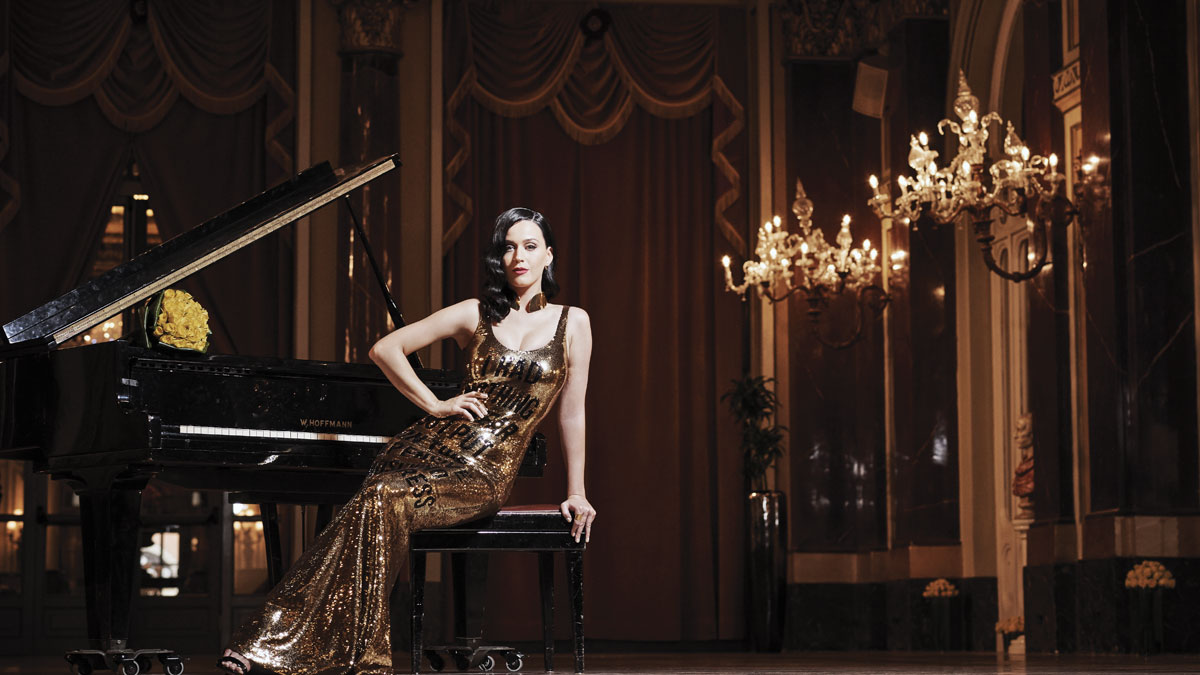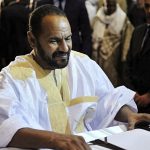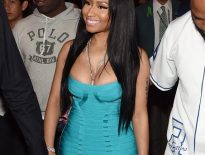My black Mercedes is weaving through Rome’s heavy traffic at dusk when a strange voice calls my cell with instructions straight from a John le Carré novel: Exit the vehicle immediately. Walk toward the Colosseum, about half a mile away. And then call back when you approach an arch.

Such are the cloak-and-dagger measures when you’re scheduled to meet Katy Perry, one of the most famous and highest-earning stars in the world. Three paparazzi had apparently been trailing my car–I hitched a ride from Perry’s driver–and so her head of security, from some seemingly omniscient location, dispatched me on foot. I pass the Forum and statues of various Caesars before coming upon the Arch of Titus, a 1,933-year-old structure that served as inspiration for the Arc de Triomphe. I call Perry’s guy, who instructs me to look to my left, where dozens of people are strolling past the 30-year-old singer, incognito in a white fedora and oversize Ray-Bans.
She is immersed in a conversation with her personal tour guide, an affable art historian who looks like an Italian version of Ron Weasley. He’s detailing the types of animals that gladiators battled on the floor of the Colosseum, which looms in the background, and she’s already finishing his sentences. So they had no idea what they were fighting, she says. He nods. A passing street merchant, apparently duped by Perry’s disguise, tries unsuccessfully to sell her a selfie stick.
I’m over this, says Perry, cheerfully. Let’s go. What else are we going to see?
You could forgive Perry for not wanting to linger. After all, she’s seen more than her share of stadiums lately thanks to her year-and-a-half-long Prismatic World Tour, which included a Super Bowl halftime performance (viewed on live TV by a record 118.5 million people) and will finally end this fall in Central America, punctuated by a headlining gig in front of 100,000 at Brazil’s Rock in Rio.
Touring explains Perry’s whopping pretax earnings of $135 million over the past 12 months, placing her at No. 3 on this year’s Celebrity 100 list, behind only the boxers Floyd Mayweather and Manny Pacquiao–who earned a one-night, once-in-a-generation payday for their snooze of a fight–and more than Taylor Swift, Rihanna and Miley Cyrus combined. But unlike some of her fellow divas, she doesn’t shy away from her financial success. I am proud of my position as a boss, as a person that runs my own company, says Perry. I’m an entrepreneur. … I don’t want to shy away from it. I actually want to kind of grab it by its balls.
That means going global. Of the 124 shows she played during our June-to-June scoring period for earnings, 75 of them took place abroad, spanning 27 different countries and four continents. Her hits translate–they’re short on subtlety, long on universal appeal, with a focus on partying (Last Friday Night), love (The One That Got Away) and celebration (Birthday). And her bright, breezy videos match: Dark Horse and Roar are the third- and fourth-most-watched YouTube videos of all time, with nearly 2 billion views between them worldwide.
So when Perry tours the world, her audience is already primed. She’s averaged a staggering $20 per head per night in merchandise sales on the tour, according to her managers, about four times the industry’s average. All in all, 60% of her total income now flows from outside of North America.
She has a talent for reaching a very wide audience, and her themes resonate across cultures, race and gender, says Chuck Leavell, keyboardist for the Rolling Stones. The music matches well with the lyrics, and the tunes are infectious. She is a true global artist.
Her success is even more impressive when you consider that industrywide annual album sales have plummeted from 785 million to 257 million over the past 15 years. Instead of grumping about Spotify like many of her fellow artists, she’s simply adapted to the times. Music has changed, she shrugs. The record is that launching pad for all kinds of other creative branches.
Notably, hitting the road. According to a report by Ibisworld, live entertainment has been growing at an annualized rate of 4.7% over the past five years and is now a $25 billion business in the U.S. alone. International statistics are harder to come by, but 10 of the 38 musicians on the Celebrity 100 played shows in at least a dozen countries over the past 12 months.
The water is far safer now. Publicly traded Live Nation and billionaire-backed AEG have professionalized markets once dominated by local operators so sketchy that American acts often had to get their cash up front or risk not getting paid. There are more territories than ever in play: After the fall of the Berlin Wall opened up pop-loving eastern Europe in the early 1990s, modern NBA-style arenas rose across the Continent. More recently, fans in Asia and South America have grown prosperous enough to pay the Western-style ticket prices necessary to support big-budget arena shows. Acts like Aerosmith are playing Paraguay, says Gary Bongiovanni, chief of touring-data outfit Pollstar. Those were things that were unheard of years ago.
THE FIRST TIME I meet Perry, a few days before our Roman holiday, I’m greeted by Butters, her chocolate-colored hypoallergenic Cavalier poodle, who races around the Los Angeles office of Perry’s managers as though it were her own private dog park.
Perry is managed by the triumvirate of Martin Kirkup, a U.K. native who focuses on marketing; Bradford Cobb, a Southerner who handles most of her music-related affairs; and industry veteran Steve Jensen, who concentrates on touring. A yellow-and-blue bedazzled football helmet emblazoned with Perry’s initials hangs above the reception desk; down the hall a full-size surfboard bearing the words Katy Perry Teen Choice 2010″ leans on a wall next to a shiny pink-red-orange-and-yellow guitar the size of Shaquille O’Neal.
After about ten minutes Perry emerges from a meeting with Cobb and Jensen sporting a black-and-white Adidas track suit, hair pulled back into a ponytail. This is her uniform at home–if she wears the same outfit every day, she discovered, the paparazzi become less interested because their photos won’t fetch as much from the gossip rags.
I like to dress up and be Katy Perry when it’s appropriate, when I’m promoting something, she explains, leading me into a conference room alone and hopping onto a semi-circular white couch. But I’m Katheryn Hudson on the business side.
Hudson is her real name. Born in Santa Barbara, Calif., Perry later took her mother’s maiden name to avoid confusion with the actress Kate Hudson. Her parents, born-again Christian ministers who constantly relocated while preaching at different churches, had little money, and Perry recalls a stretch when the family ate exclusively from a food bank. Her parents’ religious fervor was such that mentioning the forces of evil at home was forbidden. That meant no Lucky Charms cereal or even deviled eggs. Today they fully support her career, even if they don’t love her songs or provocativeness. There’s a real agree-to-disagree vibe, says Perry.
SHE STARTED SINGING at 9 and picked up guitar four years later. Soon Perry was writing songs and busking for $20 a day at local farmers’ markets; a member of her parents’ church with ties to a Christian music label in Nashville took notice. She released her little-known 2001 debut, Katy Hudson, a Christian rock album that featured songs with titles like Faith Won’t Fail. The label folded shortly thereafter, along with her faith-based music career.
Two years later a decreasingly pious but still teenage Perry got her first big break: a meeting with producer Glen Ballard, who co-wrote Michael Jackson’s Man in the Mirror and discovered Alanis Morrissette. Perry’s father drove her down to Ballard’s Los Angeles home and waited in the car while she played him a song on her guitar. I’ve been looking for you since I found Alanis, Perry remembers him saying. Adds Ballard: Like other great artists, there was some je ne sais quoi, some intangible, that I knew instantly.
Ballard signed her to his boutique label and offered her a monthly stipend of about $1,000 to move to Los Angeles; her parents agreed, on the condition that she room with a Latin gospel artist they knew. She started writing songs with Ballard. Not long after that he took her to Paris, Tokyo and Hong Kong to play gigs at fashion shows and basement clubs. We were getting better reactions outside of the U.S. than anywhere, says Ballard.
When she returned to Los Angeles, Perry stayed afloat by buying and selling clothes at local thrift shops and honed her skills at tiny clubs like Hotel Café. A gig there earned her an introduction to Cobb, who brought her to meet his partners in their office, where she made an introduction that immediately convinced them to manage her. She began doing handrolls, head over heels, Kirkup recalls. Arrived at my desk, did a split, held her hands up in the air and said, ‘Hi, I’m Katy!’
Yet their attempts to jump-start her career went nowhere. Perry struggled to make ends meet, often getting smacked with overdraft fees by her bank; at one point her leased Volkswagen Jetta was repossessed, and her managers had to start advancing her money for rent.
Finally, in 2007, Perry found a home at Capitol Records. Despite her inexperience and desperation, she displayed uncanny business savvy–with the encouragement of her managers, she insisted on a music-only deal that left her in control of her touring and merchandise revenue. She also turned down a six-figure music publishing advance, electing to keep the underlying rights–and the potential for a greater payday down the line–for herself. In 2009 her strategy paid off with the release of I Kissed a Girl, her first chart-topping single.
People were talking about bisexuality a lot that year and also talking about sexuality being fluid, says Perry of the first of many songs her parents would surely not approve of. It was zeitgeisty. It was me taking everybody’s conversation and funneling it into a song. I also knew it had that ‘ooh, ahh’ factor. I knew I could open the most doors with that first, but I wasn’t going to let that define me.
Other top-ten singles from her first album with Capitol included Waking Up in Vegas and Hot N Cold. Then in 2010 she put out Teenage Dream, which has sold almost 6 million copies in the U.S. alone and launched five singles to No. 1 on the charts–a feat pulled off previously only by Michael Jackson.
Many of Perry’s songs started taking off right around the time she launched her next tour. She played the 7,000-capacity Nokia Theater in Los Angeles before striking out for Europe and eventually Australia, all the while building up a following by playing intimate venues. By the time she returned to Los Angeles she was playing the 18,000-seat Staples Center, eventually sharing her life on the road in a 2012 documentary Part of Me, which served as a big-screen promotional video–and a profitable one at that (it grossed $33 million on a $6 million production budget).
Along the way Perry started to receive offers for all sorts of endorsement deals. She accepted a handful of seven-figure pacts, sticking to products she actually used: Proactiv, CoverGirl and Adidas. She released two fragrances, Killer Queen and Royal Revolution, for Coty (her next, Mad Potion, is due out later this year). She also took a page out of Ashton Kutcher’s book, electing to take ownership positions instead of flat fees for shilling brands like Popchips. One thing I’ve been able to do is know the power of having equity deals, she says. I don’t ever like to do things unless I’m really a part of them.
That long-term approach is already paying off, especially when it comes to touring. Perry returned to Australia last November and grossed $40 million from 23 shows before moving on to the world’s next great live market: China, where she played five concerts. People appreciate when you come. … They know how hard it is, she says. Indeed, China’s National Orchestra invited her to a performance of Roar played on traditional instruments; the event was broadcast on state-run CCTV, which boasts a viewership of more than 1 billion people.
While many acts treat their burgeoning international legs as logistical burdens, Perry, whose formal education ended with a GED at age 15, tries to turn her tours into education extensions, whether the Colosseum in Rome, the British Museum in London or the Renaissance paintings of Florence. I’m not one that stays in my hotel room, says Perry. Adds Cobb: She wants to learn. And she doesn’t care if it’s an embarrassing question.
The underlying insecurity that comes when your educational credentials don’t match up with your inherent smarts can be a compelling motivator. It can explain why she sits through business meetings and sifts through the professional minutiae other stars would delegate and why, despite her swagger and success and sex symbol appeal, she can seem the most flattered when people talk business with her. You’re calling me interesting, she says to me at one point. From the softness of her tone you’d think I’d just given her the greatest compliment she’d ever received.
YOU PROBABLY SAW the moment when Katy Perry ascended to icon status: this past Feb. 1, when she rode into the middle of University of Phoenix Stadium on an audio-animatronic lion for a 12-minute, four-outfit performance that generated as much buzz as the Super Bowl itself, down to the Left Shark meme spawned by the lackadaisical performance of a dancer in a predator suit.
Perhaps the most surprising part about the show and its aftermath is the fact that Perry didn’t have a specific product to sell (though she tried trademarking Left Shark). Unlike many recent halftime headliners, there was no new album or U.S. concerts to push–she’d already wrapped up the North American leg of her tour, and most of her international dates were sold out.
What it was, Perry realized from the onset, was a branding moment. It took her from being a big star to the stratosphere, says Jensen. He reports that since the Super Bowl, Perry’s team has been receiving about two to three big-ticket business opportunities a week from endorsements to joint ventures to movie roles, nearly double what she was getting last year. She still turns down the vast majority of them, but occasionally one strikes her fancy and she takes the plunge. This fall she’ll debut an eponymous mobile app via Glu, the startup that created Kim Kardashian’s wildly successful game; for her efforts she’ll receive a seven-figure advance and share in the revenues. She also became the face of fashion brand Moschino’s new line, and filmed a commercial for Toyota in Thailand.
There are other perks to being in the stratosphere. I don’t feel like my career is a ticking time bomb, says Perry. I don’t feel like I’ll always have to be feeding the meter of show business. I got my spot, yo.
That means Perry, who has been striving endlessly since she was a teenager, can park for a minute. As her tour winds down, she’s building in some vacation time to live life and have life experiences that influence my music. And fittingly for this woman who hadn’t left North America until she was old enough to vote, that means trips to Peru (she wants to see Machu Picchu) and Cuba–the kind of places that should keep her on the Celebrity 100 for years to come.





